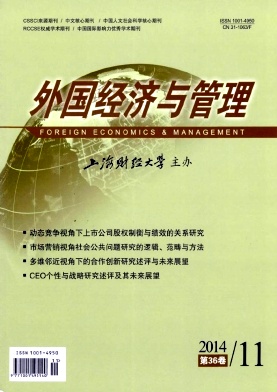多维邻近视角下的合作创新研究评述与未来展望
外国经济与管理 2014 年 第 36 卷第 11 期, 页码:45 - 54
摘要
参考文献
摘要
近年来,邻近在创新研究、组织合作研究以及区域经济发展等研究领域占据了重要位置。本文基于多维邻近的视角,详细解读了邻近与合作创新研究的相关文献。首先对前期与邻近相关的研究进行了脉络梳理,然后分别从地理邻近、认知邻近、技术邻近和社会邻近等维度评述了合作创新相关研究和进展。综述结果表明,邻近与合作创新研究主要关注地理邻近的影响,且各维度邻近性交互作用的研究尚不多见。在此基础上,本文展望了多维邻近视角下合作创新的未来研究方向。
[1]Adams J D,et al.Scientific teams and institutional collaborations:Evidence from U.S.universities,1981-1999[J].Research Policy,2005,34(3):259-285.
[2]Agrawal A,et al.Gone but not forgotten:knowledge flows,labor mobility,and enduring social relationships[J].Journal of Economic Geography,2006,6(5):571-591.
[3]Brostrom A.Working with distant researchers Distance and content in university-industry interaction[J].Research Policy,2010,39(10):1311-1320.
[4]Boschma R.Proximity and Innovation:A Critical Assessment[J].Regional Studies,2005,39(1):61-74.
[5]Branstetter L G and Sakakibara M.When do research consortia work well and why?Evidence from Japanese panel data[J].The American Economic Review,2002,92(1):143-159.
[6]Bruneel J,et al.Investigating the factors that diminish the barriers to university industry collaboration[J].Research Policy,2010,39(7):858-868.
[7]Bercovitz J and Feldman M.The mechanisms of collaboration in inventive teams:Composition,social networks,and geography[J].Research Policy,2011,40(1):81-93.
[8]Cantner U and Meder A.Technological proximity and the choice of cooperation partner[J].Journal of Economic Interaction and Coordination,2007,2(1):45-65.
[9]Ejermo O and Karlsson C.Interregional inventor net works as studied by patent coinventorships[J].Research Policy,2006,35(3):412-430.
[10]Gulati R.Social Structure and Alliance Formation Patterns:A Longitudinal Analysis[J].Administrative Science Quarterly,1995,40(4):619-652.
[11]Gittelman M.Does geography matter for science-based firms?Epistemic communities and the geo graphy of research and patenting in biotechnology[J].Organization Science,2007,18(4):724-741.
[12]Hoekman J,et al.Research collaboration at a distance:Changing spatial patt erns of scientific collaboration within Europe[J].Research Policy,2010,39(5):662-673.
[13]Hewitt-Dundas N.The role of proximity in university-business cooperation for innovation[J].The Journal of Technology Transfer,2013,38(2):93-115.
[14]Hong W and Su Y S.The effect of institutional proximity in non-local university-industry collaborations-An analysis based on Chinese patent data[J].Research Policy,2013,42(2):454-464.
[15]Hoegl M and Proserpio L.Team member proximity and teamwork in innovative projects[J].Research Policy,2004,33(8):1153-1165.
[16]Hoang H and Rothaermel F T.The Effect of General and Partner-Specific Alliance Experience on Joint R&D Project Performance[J].The Academ-y of Management Journal,2005,48(2):332-345.
[17]Kim C and Song J.Creating new technology through alliances:An empirical investigation of joint patents[J].Technovation,2007,27(8):461-470.
[18]Mora-Valentin E M.Determining factors in the success of R&D cooperative agreements between firms and research organizations[J].Research Policy,2004,33(1):17-40.
[19]Mowery D C and Oxley J E,B S.Technological overlap and interfirm cooperation:implications forthe resource-based view of the firm[J].Research Policy,1998,27(5):507-523.
[20]Maggioni M A,et al.Space versus networks in the geography of innovation:A European analysis[J].Papers in Regional Science,2007,86(3):471-493.
[21]Nooteboom B,et al.Optimal cognitive distance and absorptive cap-acity[J].Research Policy,2007,36(7):1016-1034.
[22]Narula R and Santangelo G D.Location,collocation and R&D alliances in the European ICT industry[J].Research Policy,2009,38(2):393-403.
[23]Petruzzelli A M.The impact of technological relatedness,prior ties,and geographical distance on university–industry collaborations:A joint-patent analysis[J].Technovation,2011,31(7):309-319.
[24]Singh J.Collaborative networks as determinants of knowledge diffusion patterns[J].Management Science,2005,51(5):756-770.
[25]Schartinger D,et al.Knowledge interactions between universities and industry in Austria:sectoral patterns and determinants[J].Research Policy,2002,31(3):303-328.
[26]Sampson R C.Experience effects and collaborative returns in R&D alliances[J].Strategic Management Journal,2005,26(11):1009-1031.
[27]Schwartz M,et al.What drives innovation output from subsidized R&D cooperation?—Project-level evidence from Germany[J].Technovation,2012,32(6):358-369.
[28]Whittington K B,et al.Networks,Propinquity,and Innovation in Knowledge-Intensive Industries[J].Administrative Science Quarterly,2009,54(1):90-122.
[29]党兴华,弓志刚.多维邻近性对跨区域技术创新合作的影响——基于中国共同专利数据的实证分析[J].科学学研究,2013,31(10):1590-1600.
[30]冯泰文等.合作创新研究现状探析与未来展望[J].外国经济与管理,2013,35(9):72-80.
[31]刘志迎,单洁含.技术距离、地理距离与大学-企业协同创新效应——基于联合专利数据的研究[J].科学学研究,2013,31(9):1331-1337.
[32]李琳等.地理邻近对产业集群创新影响效应的实证研究[J].中国软科学,2013,(1):167-175.
[33]吕国庆等.基于地理邻近与社会邻近的创新网络动态演化分析——以我国装备制造业为例[J].中国软科学,2014,(5):97-106.
[34]王庆喜.多维邻近与我国高技术产业区域知识溢出:一项空间面板数据分析(1995-2010)[J].科学学研究,2013,31(7):1068-1076.
[2]Agrawal A,et al.Gone but not forgotten:knowledge flows,labor mobility,and enduring social relationships[J].Journal of Economic Geography,2006,6(5):571-591.
[3]Brostrom A.Working with distant researchers Distance and content in university-industry interaction[J].Research Policy,2010,39(10):1311-1320.
[4]Boschma R.Proximity and Innovation:A Critical Assessment[J].Regional Studies,2005,39(1):61-74.
[5]Branstetter L G and Sakakibara M.When do research consortia work well and why?Evidence from Japanese panel data[J].The American Economic Review,2002,92(1):143-159.
[6]Bruneel J,et al.Investigating the factors that diminish the barriers to university industry collaboration[J].Research Policy,2010,39(7):858-868.
[7]Bercovitz J and Feldman M.The mechanisms of collaboration in inventive teams:Composition,social networks,and geography[J].Research Policy,2011,40(1):81-93.
[8]Cantner U and Meder A.Technological proximity and the choice of cooperation partner[J].Journal of Economic Interaction and Coordination,2007,2(1):45-65.
[9]Ejermo O and Karlsson C.Interregional inventor net works as studied by patent coinventorships[J].Research Policy,2006,35(3):412-430.
[10]Gulati R.Social Structure and Alliance Formation Patterns:A Longitudinal Analysis[J].Administrative Science Quarterly,1995,40(4):619-652.
[11]Gittelman M.Does geography matter for science-based firms?Epistemic communities and the geo graphy of research and patenting in biotechnology[J].Organization Science,2007,18(4):724-741.
[12]Hoekman J,et al.Research collaboration at a distance:Changing spatial patt erns of scientific collaboration within Europe[J].Research Policy,2010,39(5):662-673.
[13]Hewitt-Dundas N.The role of proximity in university-business cooperation for innovation[J].The Journal of Technology Transfer,2013,38(2):93-115.
[14]Hong W and Su Y S.The effect of institutional proximity in non-local university-industry collaborations-An analysis based on Chinese patent data[J].Research Policy,2013,42(2):454-464.
[15]Hoegl M and Proserpio L.Team member proximity and teamwork in innovative projects[J].Research Policy,2004,33(8):1153-1165.
[16]Hoang H and Rothaermel F T.The Effect of General and Partner-Specific Alliance Experience on Joint R&D Project Performance[J].The Academ-y of Management Journal,2005,48(2):332-345.
[17]Kim C and Song J.Creating new technology through alliances:An empirical investigation of joint patents[J].Technovation,2007,27(8):461-470.
[18]Mora-Valentin E M.Determining factors in the success of R&D cooperative agreements between firms and research organizations[J].Research Policy,2004,33(1):17-40.
[19]Mowery D C and Oxley J E,B S.Technological overlap and interfirm cooperation:implications forthe resource-based view of the firm[J].Research Policy,1998,27(5):507-523.
[20]Maggioni M A,et al.Space versus networks in the geography of innovation:A European analysis[J].Papers in Regional Science,2007,86(3):471-493.
[21]Nooteboom B,et al.Optimal cognitive distance and absorptive cap-acity[J].Research Policy,2007,36(7):1016-1034.
[22]Narula R and Santangelo G D.Location,collocation and R&D alliances in the European ICT industry[J].Research Policy,2009,38(2):393-403.
[23]Petruzzelli A M.The impact of technological relatedness,prior ties,and geographical distance on university–industry collaborations:A joint-patent analysis[J].Technovation,2011,31(7):309-319.
[24]Singh J.Collaborative networks as determinants of knowledge diffusion patterns[J].Management Science,2005,51(5):756-770.
[25]Schartinger D,et al.Knowledge interactions between universities and industry in Austria:sectoral patterns and determinants[J].Research Policy,2002,31(3):303-328.
[26]Sampson R C.Experience effects and collaborative returns in R&D alliances[J].Strategic Management Journal,2005,26(11):1009-1031.
[27]Schwartz M,et al.What drives innovation output from subsidized R&D cooperation?—Project-level evidence from Germany[J].Technovation,2012,32(6):358-369.
[28]Whittington K B,et al.Networks,Propinquity,and Innovation in Knowledge-Intensive Industries[J].Administrative Science Quarterly,2009,54(1):90-122.
[29]党兴华,弓志刚.多维邻近性对跨区域技术创新合作的影响——基于中国共同专利数据的实证分析[J].科学学研究,2013,31(10):1590-1600.
[30]冯泰文等.合作创新研究现状探析与未来展望[J].外国经济与管理,2013,35(9):72-80.
[31]刘志迎,单洁含.技术距离、地理距离与大学-企业协同创新效应——基于联合专利数据的研究[J].科学学研究,2013,31(9):1331-1337.
[32]李琳等.地理邻近对产业集群创新影响效应的实证研究[J].中国软科学,2013,(1):167-175.
[33]吕国庆等.基于地理邻近与社会邻近的创新网络动态演化分析——以我国装备制造业为例[J].中国软科学,2014,(5):97-106.
[34]王庆喜.多维邻近与我国高技术产业区域知识溢出:一项空间面板数据分析(1995-2010)[J].科学学研究,2013,31(7):1068-1076.
引用本文
夏丽娟, 谢富纪. 多维邻近视角下的合作创新研究评述与未来展望[J]. 外国经济与管理, 2014, 36(11): 45–54.
导出参考文献,格式为:





 5964
5964  690
690

